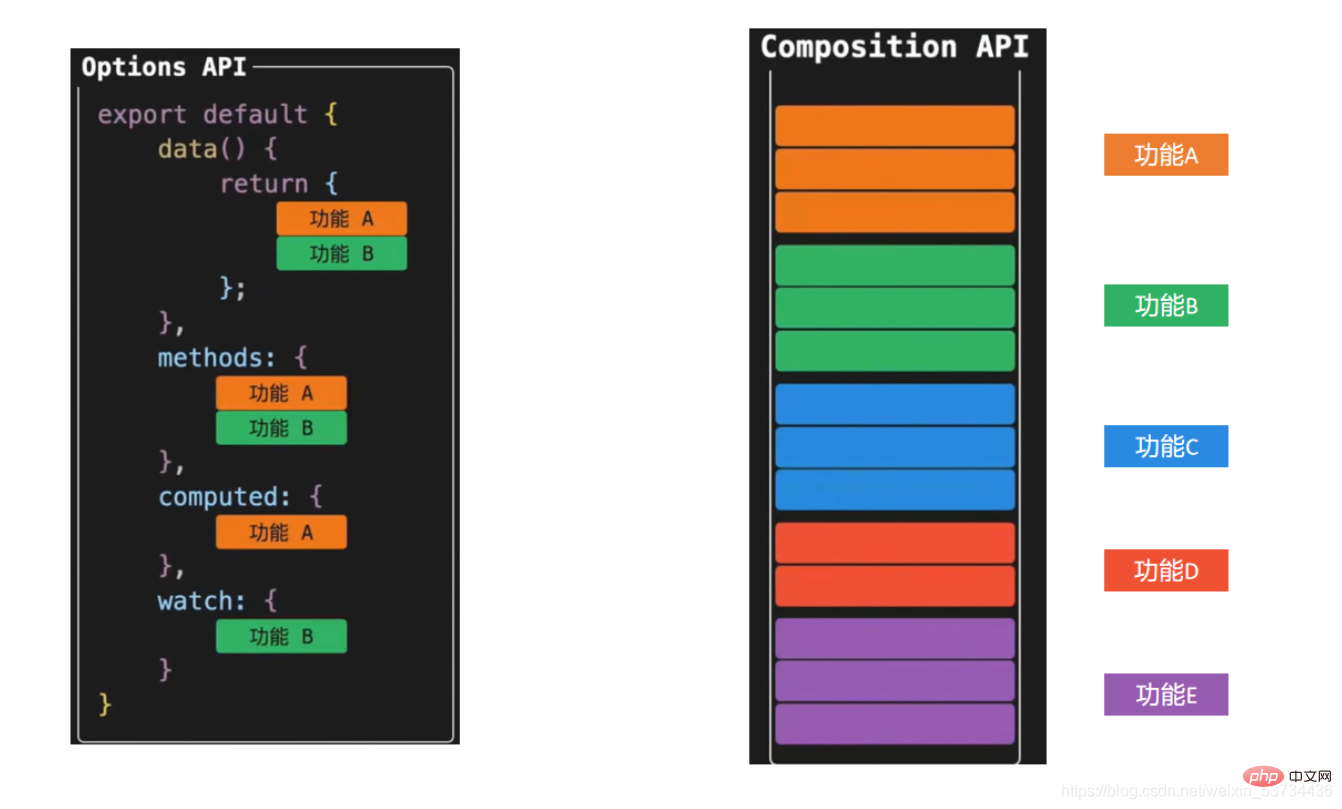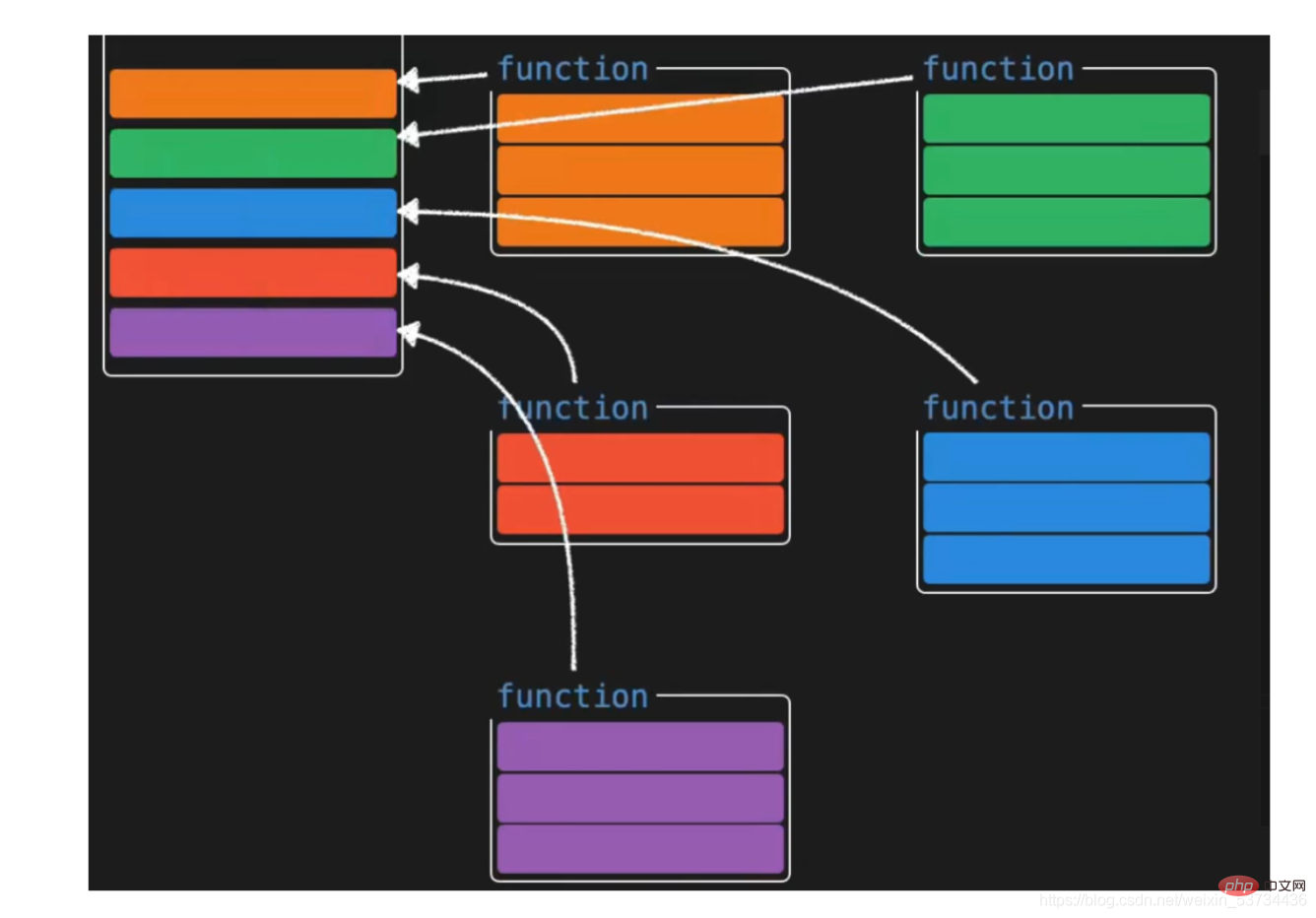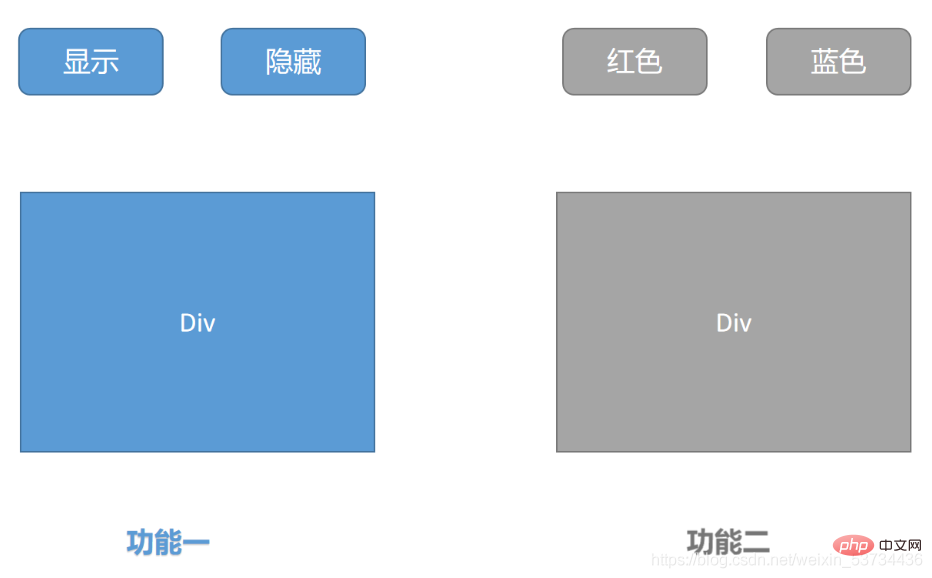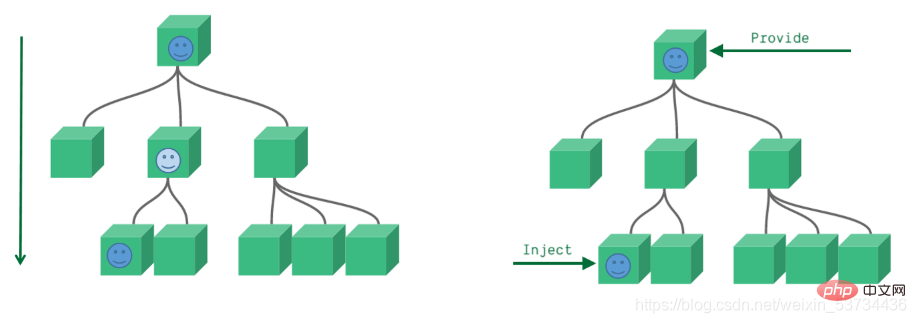超詳細!圖文講解Vue3的組合式API!
組合式API
- 組合式api(Composition API)算是vue3對我們開發者來說非常有價值的一個api更新,我們先不關注具體語法,先對它有一個大的感知
1. composition vs options
- options API開發出來的vue應用如左圖所示,它的特點是理解容易,因為各個選項都有固定的書寫位置,比如響應式資料就寫到data選擇中,操作方法就寫到methods設定項中等,應用大了之後,相信大家都遇到過來回上下找程式碼的困境
- composition API開發的vue應用如右圖所示,它的特點是特定功能相關的所有東西都放到一起維護,比如功能A相關的響應式資料,運算元據的方法等放到一起,這樣不管應用多大,都可以快讀定位到某個功能的所有相關程式碼,維護方便,設定如果功能複雜,程式碼量大,我們還可以進行邏輯拆分處理【推薦:】


特別注意: 選項式api和組合式api倆種風格是並存的關係 並不是非此即彼
需要大量的邏輯組合的場景,可以使用compition API進行增強
2. 案例對比
上面我們通過圖示簡單瞭解了一下vue3帶來的全新的api形式,下面我們通過一個具體的小案例更加深入的體會一下倆種api下的開發模式對比,我們先暫時忽略語法細節,只關注程式碼編寫形式
2.1 理解需求

倆個獨立的功能:
通過點選按鈕來控制p的顯示和隱藏
通過點選按鈕控制p內字型顏色的變化
2.2 vue2.x option Api版本
<template>
<div>
<!-- 功能一模板 -->
<button @click="show">顯示</button>
<button @click="hide">隱藏</button>
<div v-if="showDiv">一個被控制顯隱的div</div>
</div>
<div>
<!-- 功能二模板 -->
<button @click="changeRed">紅色</button>
<button @click="changeYellow">藍色</button>
<div :style="`color:${fontColor}`">一個被控制字型顏色的的div</div>
</div>
</template>
<script>
export default {
name: 'App',
data() {
return {
showDiv: true, // 功能一資料
fontColor: '' // 功能二資料
}
},
methods: {
// 功能一方法
show() {
this.showDiv = true
},
hide() {
this.showDiv = false
},
// 功能二方法
changeRed() {
this.fontColor = 'red'
},
changeYellow() {
this.fontColor = 'blue'
}
}
}
</script>2.3 vue3.0 composition api版本
<template>
<div>
<!-- 功能一模板 -->
<button @click="show">顯示</button>
<button @click="hide">隱藏</button>
<div v-if="showDivFlag">一個被控制顯隱的div</div>
</div>
<div>
<!-- 功能二模板 -->
<button @click="changeRed">紅色</button>
<button @click="changeBlue">藍色</button>
<div :style="`color:${fontColor}`">一個被控制字型顏色的的div</div>
</div>
</template>
<script>
import { ref } from 'vue'
export default {
name: 'App',
setup() {
// 功能一
const showDivFlag = ref(true)
function show() {
showDivFlag.value = true
}
function hide() {
showDivFlag.value = false
}
// 功能二
const fontColor = ref('')
function changeRed() {
fontColor.value = 'red'
}
function changeBlue() {
fontColor.value = 'blue'
}
return { showDivFlag, show, hide, fontColor, changeRed, changeBlue }
}
}
</script>2.4 composition api版本優化
在這裡可能會有疑惑,那我們現在是把功能相關的所有資料和行為放到一起維護了,如果應用很大功能很多的情況下,setup函數不會變得很大嗎?豈不是又會變得比較難維護,接下來我們就來拆解一下龐大的setup函數
<script>import { ref } from 'vue'function useShow() {
const showpFlag = ref(true)
function show() {
showpFlag.value = true
}
function hide() {
showpFlag.value = false
}
return { showpFlag, show, hide }}function useColor() {
const fontColor = ref('')
function changeRed() {
fontColor.value = 'red'
}
function changeBlue() {
fontColor.value = 'blue'
}
return { fontColor, changeRed, changeBlue }}export default {
name: 'App',
setup() {
// 功能一
const { showpFlag, show, hide } = useShow()
// 功能二
const { fontColor, changeRed, changeBlue } = useColor()
return { showpFlag, show, hide, fontColor, changeRed, changeBlue }
}}</script>以上,我們通過定義功能函數,把倆個功能相關的程式碼各自抽離到一個獨立的小函數中,然後通過在setUp函數中再把倆個小功能函陣列合起來,這樣一來,我們既可以把setup函數變得清爽,又可以方便維護快速定位功能位置
到此我們沒有關注api細節,只是體會組合式api給到我們的好處,接下來我們就要深入到api細節,看看全新的api都該如何使用 ↓
3. setup入口函數
- setup 函數是一個新的元件選項,作為元件中組合式API 的起點(入口)
- setup 中不能使用 this, this 指向 undefined
- setup函數只會在元件初始化的時候執行一次
- setup函數在beforeCreate生命週期勾點執行之前執行
export default {
setup () {
console.log('setup執行了')
console.log(this)
},
beforeCreate() {
console.log('beforeCreate執行了')
console.log(this)
}}4. 響應式系統API
4.1 reactive 函數
- 作用:reactive是一個函數,接收一個普通的物件傳入,把物件資料轉化為響應式物件並返回
使用步驟
從vue框架中匯入reactive函數
在setup函數中呼叫reactive函數並將物件資料傳入
在setup函數中把reactive函數呼叫完畢之後的返回值以物件的形式返回出去
程式碼落地
<template>
<div>{{ state.name }}</div>
<div>{{ state.age }}</div>
<button @click="state.name = 'pink'">改值</button>
</template>
<script>
import { reactive } from 'vue'
export default {
setup () {
const state = reactive({
name: 'cp',
age: 18
})
return {
state
}
}
}
</script>4.2 ref 函數
- 作用:ref是一個函數,接受一個簡單型別或者複雜型別的傳入並返回一個響應式且可變的 ref 物件
使用步驟
從vue框架中匯出ref函數
在setup函數中呼叫ref函數並傳入資料(簡單型別或者複雜型別)
在setup函數中把ref函數呼叫完畢的返回值以物件的形式返回出去
注意:在setup函數中使用ref結果,需要通過.value 存取,模板中使用不需要加.value
<template>
<div>{{ money }}</div>
<button @click="changeMondy">改值</button>
</template>
<script>
import { ref } from 'vue'
export default {
setup() {
let money = ref(100)
console.log(money.value)
return {
money
}
}
}
</script>總結說明:
ref 函數可以接收一個簡單型別的值,返回一個可改變的 ref 響應式物件,從而彌補reactive函數不支援簡單型別的問題
reactive和ref函數都可以提供響應式資料的轉換,具體什麼時候需要使用哪個API社群還沒有最佳實踐,大家暫時可以使用自己熟練的API進行轉換
推薦一種寫法:只有我們明確知道要轉換的物件內部的欄位名稱我們才使用reactive,否則就一律使用ref,從而降低在語法選擇上的心智負擔
4.3 toRefs 函數
- 場景: 經過reactive函數處理之後返回的物件,如果給這個物件解構或者展開,會讓資料丟失響應式的能力,為了解決這個問題需要引入toRefs函數,使用 toRefs函數 可以保證該物件展開的每個屬性都是響應式的
4.3.1 問題復現
還是之前的案例,如果我們想在模板中省略到state,直接書寫name和age,你可能會想到,那我在return出去的時候把state中的屬性解構出來不就好了
修改前
<template>
<div>{{ state.name }}</div>
<div>{{ state.age }}</div>
<button @click="state.name = 'pink'">改值</button>
</template>
<script>
import { reactive } from 'vue'
export default {
setup() {
const state = reactive({
name: 'cp',
age: 18
})
return {
state
}
}
}
</script>解構修改後
<template>
<div>{{ name }}</div>
<div>{{ age }}</div>
<button @click="name = 'pink'">改值</button>
</template>
<script>
import { reactive } from 'vue'
export default {
setup() {
const state = reactive({
name: 'cp',
age: 18
})
return {
...state
}
}
}
</script>- 點選改值按鈕,發現檢視已經不發生變化了,這就是我們所說的,如果解構reactive的返回值,將破壞呼叫響應式特性,就需要我們使用toRefs方法進行處理了
4.3.2 toRefs包裹處理
<template>
<div>{{ name }}</div>
<div>{{ age }}</div>
<button @click="name = 'pink'">改值</button>
</template>
<script>
import { reactive,toRefs } from 'vue'
export default {
setup() {
const state = reactive({
name: 'cp',
age: 18
})
return {
...toRefs(state)
}
}
}
</script>4.4 computed
- 在setup函數中使用計算屬性函數
作用:根據現有響應式資料經過一定的計算得到全新的資料
使用步驟
從vue框架中匯入computed 函數
在setup函數中執行computed函數,並傳入一個函數,在函數中定義計算公式
把computed函數呼叫完的執行結果放到setup的return值物件中
<template>
{{ list }}
{{ filterList }} <button @click="changeList">change list</button></template><script>import { computed, ref } from 'vue'export default {
setup() {
const list = ref([1, 2, 3, 4, 5])
// 輸入大於3的數位
const filterList = computed(() => {
return list.value.filter(item => item > 3)
})
// 修改list的函數
function changeList() {
list.value.push(6, 7, 8)
}
return {
list,
filterList,
changeList }
}}</script>4.5 watch 偵聽器
- 在setup函數中偵聽器的使用
作用:基於響應式資料的變化執行回撥邏輯,和vue2中的watch的功能完全一致
普通監聽
立即執行
深度監聽
使用步驟
從vue框架中匯入watch函數
在setup函數中執行watch函數開啟對響應式資料的監聽
watch函數接收三個常規引數
- 第一個引數為函數,返回你要監聽變化的響應式資料
- 第二個引數為響應式資料變化之後要執行的回撥函數
- 第三個引數為一個物件,在裡面設定是否開啟立刻執行或者深度監聽
4.5.1 普通監聽
<template>
{{ age }} <button @click="age++">change age</button></template><script>import { ref, watch } from 'vue'export default {
setup() {
const age = ref(18)
watch(() => {
// 返回你想要監聽的響應式屬性(ref產生的物件必須加.value)
return age.value }, () => {
// 資料變化之後的回撥函數
console.log('age發生了變化')
})
return {
age }
}}</script>4.5.2 開啟立刻執行
watch的效果預設狀態下,只有監聽的資料發生變化才會執行回撥,如果你需要在一上來的時候就立刻執行一次,需要設定一下
immediate屬性
<template>
{{ age }} <button @click="age++">change age</button></template><script>import { ref, watch } from 'vue'export default {
setup() {
const age = ref(18)
watch(() => {
// 返回你想要監聽的響應式屬性(ref產生的物件必須加.value)
return age.value }, () => {
// 資料變化之後的回撥函數
console.log('age發生了變化')
},{ immediate: true})
return {
age }
}}</script>4.5.3 開啟深度監聽
當我們監聽的資料是一個物件的時候,預設狀態下,物件內部的屬性發生變化是不會引起回撥函數執行的,如果想讓物件下面所有屬性都能得到監聽,需要開啟
deep設定
<template>
{{ name }}
{{ info.age }} <button @click="name = 'pink'">change name</button>
<button @click="info.age++">change age</button></template><script>import { reactive, toRefs, watch } from 'vue'export default {
setup() {
const state = reactive({
name: 'cp',
info: {
age: 18
}
})
watch(() => {
return state }, () => {
// 資料變化之後的回撥函數
console.log('age發生了變化')
}, {
deep: true
})
return {
...toRefs(state)
}
}}</script>4.5.4 更好的做法
使用watch的時候,儘量詳細的表明你到底要監聽哪個屬性,避免使用deep引起的效能問題,比如我僅僅只是想在state物件的age屬性變化的時候執行回撥,可以這麼寫
<template>
{{ name }}
{{ info.age }} <button @click="name = 'pink'">change name</button>
<button @click="info.age++">change age</button></template><script>import { reactive, toRefs, watch } from 'vue'export default {
setup() {
const state = reactive({
name: 'cp',
info: {
age: 18
}
})
watch(() => {
// 詳細的告知你要監聽誰
return state.info.age }, () => {
// 資料變化之後的回撥函數
console.log('age發生了變化')
})
return {
...toRefs(state)
}
}}</script>5. 生命週期函數
使用步驟
先從vue中匯入以on打頭的生命週期勾點函數
在setup函數中呼叫生命週期函數並傳入回撥函數
生命週期勾點函數可以呼叫多次
<template>
<div>生命週期函數</div>
</template>
<script>
import { onMounted } from 'vue'
export default {
setup() {
// 時機成熟 回撥函數自動執行
onMounted(() => {
console.log('mouted生命週期執行了')
})
onMounted(() => {
console.log('mouted生命週期函數又執行了')
})
}
}
</script>| 選項式API | 組合式API |
|---|---|
beforeCreate | 不需要(直接寫到setup函數中) |
created | 不需要(直接寫到setup函數中) |
beforeMount | onBeforeMount |
mounted | onMounted |
beforeUpdate | onBeforeUpdate |
updated | onUpdated |
beforeDestroyed | onBeforeUnmount |
destroyed | onUnmounted |
6. 父子通訊
在vue3的組合式API中,父傳子的基礎套路完全一樣,基礎思想依舊為:父傳子是通過prop進行傳入,子傳父通過呼叫自定義事件完成
實現步驟
setup函數提供倆個引數,第一個引數為props,第二個引數為一個物件context
props為一個物件,內部包含了父元件傳遞過來的所有prop資料,context物件包含了attrs,slots, emit屬性,其中的emit可以觸發自定義事件的執行從而完成子傳父
程式碼落地app.vue
<template>
<son :name="name" @get-msg="getMsg"></son></template><script>import { ref } from 'vue'import Son from './components/son'export default {
components: {
Son },
setup() {
const name = ref('cp')
function getMsg(msg) {
console.log(msg)
}
return {
name,
getMsg }
}}</script>components/son.vue
<template>
<div>
{{name}}
<button @click="setMsgToSon">set</button>
</div>
</template>
<script>
export default {
props: {
name: {
type: String
}
},
emits: ['get-msg'], // 宣告當前元件觸發的自定義事件
setup(props,{emit}) {
console.log(props.name)
function setMsgToSon(){
emit('get-msg','這是一條來自子元件的msg資訊')
}
return {
setMsgToSon
}
}
}
</script>7. provide 和 inject
通常我們使用props進行父子之間的資料傳遞,但是如果元件巢狀層級較深,一層一層往下傳遞將會變的非常繁瑣,有沒有一種手段可以把這個過程簡化一下呢,有的,就是我們馬上要學習的provide 和 inject,它們配合起來可以方便的完成跨層傳遞資料

7.1 基礎使用
- 在setup函數中使用provide和inject的基礎用法
來個需求: 爺元件中有一份資料 傳遞給孫元件直接使用
實現步驟:
頂層元件在setup方法中使用provide函數提供資料
任何底層元件在setup方法中使用inject函數獲取資料
程式碼落地爺爺元件 - app.vue
<template>
<father></father></template><script>import Father from '@/components/Father'import { provide } from 'vue'export default {
components: {
Father },
setup() {
let name = '柴柴老師'
// 使用provide設定項注入資料 key - value
provide('name', name)
}}</script>孫元件 - components/Son.vue
<template>
我是子元件
{{ name }}</template><script>import { inject } from 'vue'export default {
setup() {
const name = inject('name')
return {
name }
}}</script>事實上,只要是後代元件,都可以方便的獲取頂層元件提供的資料
7.2 傳遞響應式資料
provide預設情況下傳遞的資料不是響應式的,也就是如果對provide提供的資料進行修改,並不能響應式的影響到底層元件使用資料的地方,如果想要傳遞響應資料也非常簡單,只需要將傳遞的資料使用ref或者reactive生成即可
- 通過provide/inject傳遞響應式資料
app.vue
<template>
<father></father>
<button @click="changeName">change name</button></template><script>import Father from '@/components/Father'import { provide, ref } from 'vue'export default {
components: {
Father },
setup() {
// 使用ref轉換成響應式再傳遞
let name = ref('柴柴老師')
function changeName(){
name.value = 'pink'
}
provide('name', name)
return {
changeName }
}}</script>8. 模板中 ref 的使用
在模板中使用ref,我們都很清楚,它一般有三種使用場景
ref + 普通dom標籤 獲取真實dom物件
ref + 元件標籤 獲取元件範例物件
ref + v-for 獲取由dom物件(範例物件)組成的陣列 (不經常使用)
- 在setup函數中使用ref獲取真實dom獲取元件範例的方法
實現步驟
使用ref函數傳入null建立 ref物件 =>
const hRef = ref(null)模板中通過定義ref屬性等於1中建立的ref物件名稱建立關聯 =>
<h1 ref="hRef"></h1>使用 =>
hRef.value
程式碼落地components/RefComponent.vue
<template> 我是一個普通的元件</template>
app.vue
<template>
<h1 ref="h1Ref">我是普通dom標籤</h1>
<ref-comoonent ref="comRef"></ref-comoonent></template><script>import { onMounted, ref } from 'vue'import RefComoonent from '@/components/RefComponent'export default {
components: {
RefComoonent },
setup() {
const h1Ref = ref(null)
const comRef = ref(null)
onMounted(() => {
console.log(h1Ref.value)
console.log(comRef.value)
})
// 必須return
return {
h1Ref,
comRef }
}}</script>9. 來個案例吧 - Todos
核心功能
渲染列表資料 v-for
點選刪除當前列表 splice + index
回車新增新專案 @keyup.enter=「addTodo」 list.unshift
選擇狀態切換 v-model
多選和取消多選 計算屬性的set和get
未完成任務數量統計 computed
<template>
<section class="todoapp">
<!-- 頭部輸入框區域 -->
<header class="header">
<h1>todos</h1>
<input
class="new-todo"
placeholder="請輸入要完成的任務"
autofocus
v-model="curTask"
@keyup.enter="add"
/>
</header>
<section class="main">
<!-- 全選切換input -->
<input id="toggle-all" class="toggle-all" type="checkbox" v-model="isAll"/>
<label for="toggle-all">標記所有已經完成</label>
<ul class="todo-list">
<!-- 任務列表 -->
<li v-for="(item, index) in list" :key="item.id">
<p class="view">
<!-- 雙向繫結 flag -->
<input class="toggle" type="checkbox" v-model="item.flag" />
<label>{{ item.name }}</label>
<!-- 刪除按鈕 -->
<button class="destroy" @click="del(index)"></button>
</p>
</li>
</ul>
</section>
<footer class="footer">
<span class="todo-count"> 還未完成的任務有:<strong>{{count}}</strong>項 </span>
</footer>
</section></template><script>import { computed, ref } from 'vue'export default {
setup() {
const list = ref([
{ id: 1, name: '吃飯', flag: false },
{ id: 2, name: '睡覺', flag: false },
{ id: 3, name: '打豆豆', flag: true }
])
// 刪除函數
function del(index) {
// index 要刪除項的下標值
// splice
list.value.splice(index, 1)
}
const curTask = ref('')
function add() {
// 新增邏輯
list.value.unshift({
id: new Date(),
name: curTask.value,
flag: false
})
curTask.value = ''
}
// 全選取消全選
// {name:"cp"} console.log(info.name) info.name = 'pink'
const isAll = computed({
// 獲取isAll資料的時候會執行get函數
get() {
// 當list列表中所有項的flag屬性都為true 就為true
// every
return list.value.every(item => item.flag === true)
},
set(val) {
// 拿到isAll最新值 遍歷一下list 把裡面的flag屬性設定為最新值
list.value.forEach(item => {
item.flag = val })
}
})
// 計算未完成的任務
const count = computed(()=>{
return list.value.filter(item=>item.flag === false).length })
return {
list,
del,
curTask,
add,
isAll,
count }
}}</script><style>html,
body {
margin: 0;
padding: 0;}button {
margin: 0;
padding: 0;
border: 0;
background: none;
font-size: 100%;
vertical-align: baseline;
font-family: inherit;
font-weight: inherit;
color: inherit;
-webkit-appearance: none;
appearance: none;
-webkit-font-smoothing: antialiased;
-moz-osx-font-smoothing: grayscale;}body {
font: 14px "Helvetica Neue", Helvetica, Arial, sans-serif;
line-height: 1.4em;
background: #f5f5f5;
color: #111111;
min-width: 230px;
max-width: 550px;
margin: 0 auto;
-webkit-font-smoothing: antialiased;
-moz-osx-font-smoothing: grayscale;
font-weight: 300;}:focus {
outline: 0;}.hidden {
display: none;}.todoapp {
background: #fff;
margin: 130px 0 40px 0;
position: relative;
box-shadow: 0 2px 4px 0 rgba(0, 0, 0, 0.2), 0 25px 50px 0 rgba(0, 0, 0, 0.1);}.todoapp input::-webkit-input-placeholder {
font-style: italic;
font-weight: 300;
color: rgba(0, 0, 0, 0.4);}.todoapp input::-moz-placeholder {
font-style: italic;
font-weight: 300;
color: rgba(0, 0, 0, 0.4);}.todoapp input::input-placeholder {
font-style: italic;
font-weight: 300;
color: rgba(0, 0, 0, 0.4);}.todoapp h1 {
position: absolute;
top: -140px;
width: 100%;
font-size: 80px;
font-weight: 200;
text-align: center;
color: #b83f45;
-webkit-text-rendering: optimizeLegibility;
-moz-text-rendering: optimizeLegibility;
text-rendering: optimizeLegibility;}.new-todo,
.edit {
position: relative;
margin: 0;
width: 100%;
font-size: 24px;
font-family: inherit;
font-weight: inherit;
line-height: 1.4em;
color: inherit;
padding: 6px;
border: 1px solid #999;
box-shadow: inset 0 -1px 5px 0 rgba(0, 0, 0, 0.2);
box-sizing: border-box;
-webkit-font-smoothing: antialiased;
-moz-osx-font-smoothing: grayscale;}.new-todo {
padding: 16px 16px 16px 60px;
border: none;
background: rgba(0, 0, 0, 0.003);
box-shadow: inset 0 -2px 1px rgba(0, 0, 0, 0.03);}.main {
position: relative;
z-index: 2;
border-top: 1px solid #e6e6e6;}.toggle-all {
width: 1px;
height: 1px;
border: none; /* Mobile Safari */
opacity: 0;
position: absolute;
right: 100%;
bottom: 100%;}.toggle-all + label {
width: 60px;
height: 34px;
font-size: 0;
position: absolute;
top: -52px;
left: -13px;
-webkit-transform: rotate(90deg);
transform: rotate(90deg);}.toggle-all + label:before {
content: "❯";
font-size: 22px;
color: #e6e6e6;
padding: 10px 27px 10px 27px;}.toggle-all:checked + label:before {
color: #737373;}.todo-list {
margin: 0;
padding: 0;
list-style: none;}.todo-list li {
position: relative;
font-size: 24px;
border-bottom: 1px solid #ededed;}.todo-list li:last-child {
border-bottom: none;}.todo-list li.editing {
border-bottom: none;
padding: 0;}.todo-list li.editing .edit {
display: block;
width: calc(100% - 43px);
padding: 12px 16px;
margin: 0 0 0 43px;}.todo-list li.editing .view {
display: none;}.todo-list li .toggle {
text-align: center;
width: 40px;
/* auto, since non-WebKit browsers doesn't support input styling */
height: auto;
position: absolute;
top: 0;
bottom: 0;
margin: auto 0;
border: none; /* Mobile Safari */
-webkit-appearance: none;
appearance: none;}.todo-list li .toggle {
opacity: 0;}.todo-list li .toggle + label {
background-image: url("data:image/svg+xml;utf8,%3Csvg%20xmlns%3D%22http%3A//www.w3.org/2000/svg%22%20width%3D%2240%22%20height%3D%2240%22%20viewBox%3D%22-10%20-18%20100%20135%22%3E%3Ccircle%20cx%3D%2250%22%20cy%3D%2250%22%20r%3D%2250%22%20fill%3D%22none%22%20stroke%3D%22%23ededed%22%20stroke-width%3D%223%22/%3E%3C/svg%3E");
background-repeat: no-repeat;
background-position: center left;}.todo-list li .toggle:checked + label {
background-image: url("data:image/svg+xml;utf8,%3Csvg%20xmlns%3D%22http%3A//www.w3.org/2000/svg%22%20width%3D%2240%22%20height%3D%2240%22%20viewBox%3D%22-10%20-18%20100%20135%22%3E%3Ccircle%20cx%3D%2250%22%20cy%3D%2250%22%20r%3D%2250%22%20fill%3D%22none%22%20stroke%3D%22%23bddad5%22%20stroke-width%3D%223%22/%3E%3Cpath%20fill%3D%22%235dc2af%22%20d%3D%22M72%2025L42%2071%2027%2056l-4%204%2020%2020%2034-52z%22/%3E%3C/svg%3E");}.todo-list li label {
word-break: break-all;
padding: 15px 15px 15px 60px;
display: block;
line-height: 1.2;
transition: color 0.4s;
font-weight: 400;
color: #4d4d4d;}.todo-list li.completed label {
color: #cdcdcd;
text-decoration: line-through;}.todo-list li .destroy {
display: none;
position: absolute;
top: 0;
right: 10px;
bottom: 0;
width: 40px;
height: 40px;
margin: auto 0;
font-size: 30px;
color: #cc9a9a;
margin-bottom: 11px;
transition: color 0.2s ease-out;}.todo-list li .destroy:hover {
color: #af5b5e;}.todo-list li .destroy:after {
content: "×";}.todo-list li:hover .destroy {
display: block;}.todo-list li .edit {
display: none;}.todo-list li.editing:last-child {
margin-bottom: -1px;}.footer {
padding: 10px 15px;
height: 20px;
text-align: center;
font-size: 15px;
border-top: 1px solid #e6e6e6;}.footer:before {
content: "";
position: absolute;
right: 0;
bottom: 0;
left: 0;
height: 50px;
overflow: hidden;
box-shadow: 0 1px 1px rgba(0, 0, 0, 0.2), 0 8px 0 -3px #f6f6f6,
0 9px 1px -3px rgba(0, 0, 0, 0.2), 0 16px 0 -6px #f6f6f6,
0 17px 2px -6px rgba(0, 0, 0, 0.2);}.todo-count {
float: left;
text-align: left;}.todo-count strong {
font-weight: 300;}.filters {
margin: 0;
padding: 0;
list-style: none;
position: absolute;
right: 0;
left: 0;}.filters li {
display: inline;}.filters li a {
color: inherit;
margin: 3px;
padding: 3px 7px;
text-decoration: none;
border: 1px solid transparent;
border-radius: 3px;}.filters li a:hover {
border-color: rgba(175, 47, 47, 0.1);}.filters li a.selected {
border-color: rgba(175, 47, 47, 0.2);}.clear-completed,
html .clear-completed:active {
float: right;
position: relative;
line-height: 20px;
text-decoration: none;
cursor: pointer;}.clear-completed:hover {
text-decoration: underline;}.info {
margin: 65px auto 0;
color: #4d4d4d;
font-size: 11px;
text-shadow: 0 1px 0 rgba(255, 255, 255, 0.5);
text-align: center;}.info p {
line-height: 1;}.info a {
color: inherit;
text-decoration: none;
font-weight: 400;}.info a:hover {
text-decoration: underline;}/*
Hack to remove background from Mobile Safari.
Can't use it globally since it destroys checkboxes in Firefox
*/@media screen and (-webkit-min-device-pixel-ratio: 0) {
.toggle-all,
.todo-list li .toggle {
background: none;
}
.todo-list li .toggle {
height: 40px;
}}@media (max-width: 430px) {
.footer {
height: 50px;
}
.filters {
bottom: 10px;
}}</style>以上就是超詳細!圖文講解Vue3的組合式API!的詳細內容,更多請關注TW511.COM其它相關文章!
